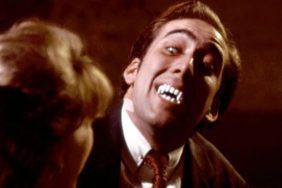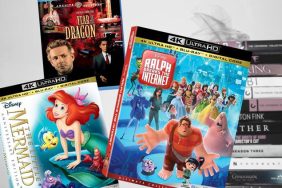In addition to talking with the three lead actors of Dracula Untold, CraveOnline was able to have a few conversations with the film’s hardworking creative staff. Executive producer Alissa Phillips was able to give us an entire rundown on the story, the themes, and the overall tone of Dracula Untold, all with a detailed enthusiasm. We also talked with the Academy Award-winning costume designer Ngila Dickson about what look she wanted to achieve, and what her process was like. Our conversation with production designer François Audouy can’t be transcribed directly because one, it was too visually oriented, and two, he gives away a lot of key details about the plot. I can, however, describe some of the awesome designs he came up with.
Related: Dracula Untold: Cast Interviews
Read on, friends, and learn all about Dracula Untold.
Alissa Phillips

Alissa Phillips: You came in for a really fun scene. It was not the same as this yesterday. Yesterday the great hall was a light space full of tables and regal people and food and it’s a feast, and now it is under siege. So it was quite exciting, even for me, walking in this morning, because it looks nothing like it did when I left last night.
This is the origin tale of Dracula, which I don’t think has ever been done before. It’s Vlad III of historical records, sometimes known as Vlad Ţepeş, which means “The Impaler,” so he was known as Vlad the Impaler. The original writers, Matt [Sazama] and Burk [Sharpless] – this is an original screenplay, six years ago, I read it, and Mike DeLuca who I work with liked it – but this was their own idea. Matt and Burk thought “We know Bram Stoker, in the 1890s, wrote this wonderful Victorian England Gothic story of Dracula.” Whch Bram Stoker, of course, based on Vlad Ţepeş of historical record. And so the violence associated with him, from the 1400s, and certainly carried into the 1800s, and Bram wrote this wonderful fictional tale of Dracula. The writers, Matt and Burk, six years ago, decided to ask “How did he become that? How did he get to be Dracula in the 1800s?” And so it was their idea to do an origin tale, very much in the vein of what we see in a lot of films now.
So they went back to the reign of Vlad III, and that’s where our story starts. In the 1400s. When you meet Vlad, he’s a good king. He’s a good ruler. He’s married to a wonderful woman, played by Sarah Gadon. He has a loving son. His land is at peace. What we call Transylvania in the film, it was called Wallachia then. It’s modern-day Romania. His land is at peace, but that peace, as we learn in Act I, is a tenuous peace. He’s been able to keep his people safe by paying homage to the Turks and Mehmed II.
In our film, this is all based on history. The writers did tons and tons of research. In many ways, and in many places, it lines up with what we believe was the case. Sometimes in incredibly specific ways. In our script, when you meet him, he’s a happy king. But he does have a dark past that you realize is there. The backstory of Vlad is that he had been raised in the court of Sultan Mehmed I, the father of the character played by Dominic Cooper. He’d been taken as a hostage, raised in this court, raised very violently, trained to kill – this is Vlad. When we meet him, he’s Luke Evans, 30, and he’s trying to hide that part. He doesn’t want to be that violent person anymore. He has no desire to be that guy. He wants to be the good king.
But Mehmed II comes calling, asking for tribute as means of keeping peace. But he also comes asking for something else. Which is the inciting incident which drives our film. He comes to court asking – through his emissary – I know you guys pay us tribute, and we’re besieging all of Europe, I also need boys to help fight the soldiers. I need a thousand of them. He needs emissaries, which is, according to historical record, exactly what Vlad was raised as. Very trained fighters. And so Vlad doesn’t want to give up his people’s sons, and as the story progresses, Mehmed continues to ask for Vlad’s own son as part of that thousand.
And that’s what drives the film. The father/son dynamic. Not wanting to give up his people, wanting to retain the peace, and being forced to do things that are very very drastic. To save his people. That’s the real impetus. And that’s what Matt and Burk set out to do. Sort of motivate how he became Dracula. How did he end up there? He ended up there because he was forced to. Because the Ottomans were besieging his small land, asking for his son – all their sons – and he had to go to great, extraordinary lengths to protect his people.
The scene [we’re filming today] is the scene where he’s returning. He said “no” to Mehmed, he said “no, I’m not giving you my thousand boys. I’m also not giving you my own son, Indras.” He’s [SPOILERS REDACTED].
The story is about fate. And, even though Vlad has tried very hard to deny his impaling past – people ask if there’s impaling in the movie. No. The impaling took place before the movie started – he was an impaler in the Turkish war, before he’s king. Even though he’s tried so hard not to go to that violent place, he’s been forced to. So he’s actually [SPOILERS REDACTED]. He’s found the power he seeks, and he’s now come back to the castle. He’s returned, and he’s going to look a bit disheveled. He’s been through a lot. And the castle is under siege because Mehmed is so mad that Vlad denied his request. And the Transylvanians have no chance. I was actually reading historical records, and Matt and Burk got that right. At the time this all happened, Vlad has in the neighborhood of 40,000 troops total. And Mehmed had a couple hundred thousand. So it would have been a slaughter. That’s what you’re seeing and why it’s all damaged.
This scene, by the way, is right at the beginning of the second act. This is way before the third act. He’s drank [SPOILER REDACTED]‘s blood at the end of the first act, and now he is returning. And, I’m not spoiling anything, but they’re going to win the battle, and the characters will be like “How did we win that battle?” Some trickery in the battle sequence, and they’ll be like “Wow! We fought a lot of Turks and won!”
The history of Mehmed II and Vlad III, and this is of historical record, they were raised together in the court of Mehmed I. So they were raised as brothers, so to speak. And that’s very much a theme of our film. That these two… Mehmed has a lot of pent-up anger because Vlad was a better child. Once Vlad has said no to Mehmed, and they’re the same age, Mehmed is gonna keep coming. Hes not going to lose. And that’s how the rest of the film is going to play out.
Why an unknown director?
It’s not that unusual. They way to make older directors is get them started as younger ones. But [Gary Shore], I had seen his short The Draft, which is online, and it’s very stylized, and there’s such an aesthetic and a vision there. And I wanted to meet him! And when I met him, the first thing he said was “It’s a father/son story.” And for us, that was exactly what we wanted to hear. Because he went right for character. There’s a lot of spectacle, there’s visual effects, there’s tons of cool stuff. And a lot of directors would be like “Oh my God! I can’t wait to shoot the bats!” But he, smartly, went right for what makes a film great. Which is character. On multiple levels, the themes of this film are father/son tragedy, love, romance, fate. All these sort of broader themes come right from that.
The second thing he said to us was “If you want to do a gory, bloody vampire film, then I don’t wanna do that.” And that’s what we also wanted to hear. We felt there’s a canon of fabulous films that are all vampiric, and we weren’t trying to do that. We’re trying to do a hero story. We’re trying to do something different. To let our audience in on the choices that Vlad Ţepeş made. So that we feel sympathy for him. We thought a lot about William Wallace from Braveheart. If you look at the opposite side of that, you might feel very different about William Wallace. But we wanted to ask How Vlad Ţepeş arrived at that point. Gary got that. And he didn’t want to make an R-rated gory horror film.
You’ll find that’s it’s an epic, sweeping action fantasy film. It’s much more like Lord of the Rings, tonally. I intend to bring my children to it. Which is obviously a bias. But I also brought them to Lord of the Rings. We want kids to enjoy this. And we have no intention of… there’s already plenty of blood with vampires. You can turn on “True Blood” any night. Blood is an iconic ongoing image with vampires, you can’t avoid that. But gore doesn’t have to be. If you want to see a film about Vlad the Impaler impaling people, this is not it.








